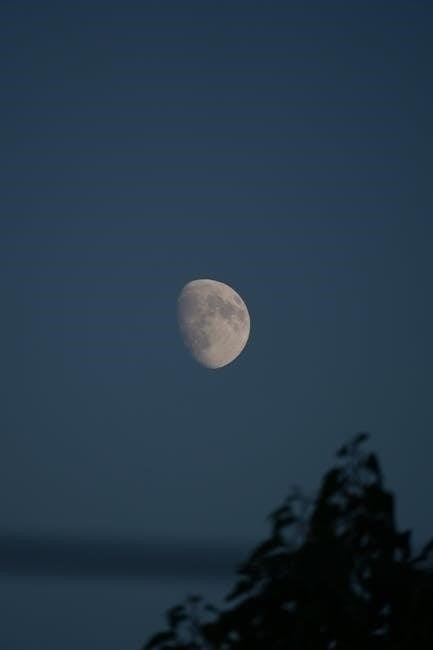Kenny Dorham’s “Blue Bossa,” composed in 1963, is a timeless jazz standard blending bossa nova rhythms with rich harmonies. Its enduring appeal lies in its simplicity and sophistication, making it a staple in jazz education and performances worldwide;
Overview of the Song and Its Composer
Kenny Dorham’s “Blue Bossa,” composed in 1963, is a celebrated jazz standard that masterfully blends bossa nova rhythms with intricate harmonic structures. Dorham, an accomplished trumpeter and composer, created this piece during a pivotal era in jazz history. The song’s enduring popularity stems from its melodic simplicity and rich harmonic depth, making it a favorite among musicians and educators. “Blue Bossa” was first featured on Dorham’s album Bossa Nova and later gained widespread recognition through interpretations by artists like Joe Henderson and Dexter Gordon. Its structure and chord progressions have become a benchmark for jazz education, while its rhythmic feel continues to inspire performances across genres. As a testament to its timeless appeal, “Blue Bossa” remains a cornerstone of jazz repertoire, offering endless opportunities for improvisation and artistic expression.
Historical Significance in Jazz Music
Kenny Dorham’s “Blue Bossa” holds a significant place in jazz history as one of the first compositions to merge bossa nova with modern jazz. Emerging in the early 1960s, it bridged cultural gaps by introducing Brazilian rhythms to American jazz, influencing a generation of musicians. The song’s harmonic complexity and melodic simplicity set a new standard for jazz composition, making it a foundational piece in jazz education. Its widespread adoption by artists like Joe Henderson and Dexter Gordon further cemented its legacy. “Blue Bossa” is often cited as a key work in the evolution of jazz, demonstrating how global influences could shape the genre. Its enduring popularity underscores its importance as a historical milestone, continuing to inspire musicians and educators today.

Structure and Musical Elements
“Blue Bossa” is a 32-bar composition in the AABA form, written in a moderate bossa nova tempo (around 120 BPM). The song features a memorable melody over a harmonic structure that includes extended chords like Dm7, Gm7, and EØ7, creating a rich, modern jazz sound. The chord progressions are repetitive yet intricate, allowing for both improvisation and ensemble playing. The rhythm section is driven by the bossa nova groove, characterized by syncopation and a steady, lilting feel. The interplay between melody and harmony, along with the use of modal interchange, makes “Blue Bossa” a versatile piece for soloists and ensembles alike. Its structure and musical elements have become a benchmark for jazz standards, blending simplicity with sophistication to create a timeless appeal.
Blue Bossa PDF: Availability and Features
The “Blue Bossa” PDF is widely available on platforms like MuseScore.com, offering free downloads for instruments such as piano, guitar, and saxophone. It features detailed chord progressions, notation, and arrangements, making it a valuable resource for musicians.
Downloading the Sheet Music from Musescore.com
Musescore.com provides free and easy access to “Blue Bossa” sheet music, allowing users to download or print the PDF for instruments like piano, guitar, flute, and more. The platform features a vast library of user-contributed and professionally arranged scores, ensuring high quality and accuracy. Musicians can explore various arrangements, from solo piano versions to ensemble scores, tailored to different skill levels. The sheet music includes detailed chord progressions, notation, and harmonic structures, making it a valuable resource for both practice and performance. Additionally, Musescore.com offers the option to download in MIDI format, enabling further customization and learning opportunities. With its user-friendly interface and extensive collection, Musescore.com has become a go-to destination for accessing “Blue Bossa” and other jazz standards.
Instrument-Specific Arrangements
The “Blue Bossa” PDF offers a wide range of instrument-specific arrangements, catering to diverse musical needs. For pianists, the sheet music includes intricate chord voicings and harmonic progressions, while guitarists can access detailed tabs and chord charts. Saxophonists and trumpeters benefit from solo transcriptions, such as Dexter Gordon’s iconic saxophone solo, providing insight into improvisational techniques. Additionally, arrangements for flute, bass guitar, and mixed quartets are available, making the piece adaptable to various ensembles. These arrangements are thoughtfully crafted to preserve the song’s essence while accommodating different skill levels and instrumental preferences. Whether for solo performance or group play, the “Blue Bossa” PDF ensures every musician can engage with this jazz classic in a way that suits their instrument and style.
Chord Progressions and Notation Details

The “Blue Bossa” PDF provides a detailed breakdown of its iconic chord progressions, featuring extended harmonic structures such as Dm7, Gm7, and EØ7. These chords form the backbone of the song’s melancholic yet sophisticated feel. The notation includes clear time signatures, typically in 4/4, with a moderate bossa nova tempo around 120 BPM. Musicians will find precise markings for rests, syncopation, and rhythmic accents, essential for capturing the tune’s rhythmic essence. The PDF also highlights extended voicings, such as A7(b9) and Dm7, which add depth to the harmonic landscape. Additionally, the sheet music includes key signatures, with sections in C minor and G minor, guiding players through the song’s modal interchange. These details ensure that the chord progressions and notation are both accessible and faithful to Kenny Dorham’s original composition.
Instruments Featured in Blue Bossa
The “Blue Bossa” PDF includes arrangements for piano, guitar, flute, bass guitar, trumpet, tenor saxophone, and alto saxophone, offering versatility for various instrumental interpretations of the jazz standard.
Piano Sheet Music and Chord Voicings
The “Blue Bossa” PDF offers detailed piano sheet music, featuring lush chord voicings and harmonic progressions. These arrangements are ideal for intermediate to advanced pianists, providing a rich foundation for improvisation. The sheet music includes chord symbols, allowing for creative interpretations while maintaining the song’s essence. Available on platforms like MuseScore, the piano arrangements are often paired with flute, bass guitar, and other instruments, creating a versatile ensemble experience. The chord voicings are structured to reflect the bossa nova style, with extended chords like Dm7, Gm7, and EØ7, which add depth and complexity. This makes the piano part both challenging and rewarding, perfect for jazz enthusiasts and educators seeking to explore harmonic richness in a classic standard.

Guitar Tabs and Chord Charts
Guitarists can access “Blue Bossa” PDFs featuring detailed tabs and chord charts, ideal for both beginners and advanced players. These resources, available on platforms like MuseScore, provide accurate chord shapes and progressions, ensuring a smooth learning experience. The chord charts highlight the song’s iconic bossa nova rhythm, emphasizing chords like Dm7, Gm7, and EØ7, which are central to its harmonic structure. Tabs are often paired with standard notation, catering to players who prefer visual or traditional learning methods. Additionally, many arrangements include fretboard diagrams, making it easier to grasp complex chord voicings. The availability of these materials allows guitarists to explore the song’s rich harmonic landscape while maintaining its signature bossa nova feel, making “Blue Bossa” a rewarding piece for jazz guitar enthusiasts.
Saxophone Solo Transcriptions
Saxophonists can find detailed transcriptions of “Blue Bossa” solos, particularly Dexter Gordon’s iconic rendition, in PDF format. These transcriptions are available for both alto and tenor saxophones, capturing the nuanced phrasing and improvisational brilliance of the original performances. The sheet music often includes the song’s Bb instrument arrangement, ensuring compatibility with standard saxophone tuning. Notable features include the transcription of Gordon’s solo from “Biting the Apple,” which showcases his mastery of the bossa nova style. The PDFs typically outline the melody, chord changes, and rhythmic nuances, allowing saxophonists to study and replicate the performance with precision. These resources are invaluable for jazz students and professionals alike, offering insights into the artistry behind “Blue Bossa” while providing a foundation for their own interpretations.
Trumpet and Tenor Parts
The trumpet and tenor parts for “Blue Bossa” are widely available in PDF format, offering musicians detailed notation and chord progressions. These arrangements, often transcribed from Kenny Dorham’s original composition, provide a clear guide for both trumpet and tenor saxophone players. The sheet music typically includes the song’s harmonic structure, with chords like Dm7, Gm7, and EØ7, allowing for precise execution. Notably, Joe Henderson’s rendition of “Blue Bossa” features a tenor saxophone part that has been transcribed and is popular among jazz enthusiasts. The PDFs often include dynamic markings and articulations, ensuring authenticity to the original performance. These resources are ideal for both educational purposes and professional rehearsals, making “Blue Bossa” accessible to a wide range of musicians while preserving its timeless appeal.

Chord Progressions and Harmony
“Blue Bossa” features iconic Dm7, Gm7, and EØ7 chords, creating a smooth, bossa nova-inspired harmonic flow. These progressions are central to its timeless appeal and are detailed in the PDF sheet music.
Dm7, Gm7, and EØ7 Chords Explained
The Dm7 (D minor 7th) and Gm7 (G minor 7th) chords form the harmonic foundation of “Blue Bossa,” creating a smooth, soulful progression. The EØ7 (E half-diminished 7th) adds a touch of tension, resolving seamlessly into the A7(b9). These chords are central to the song’s bossa nova feel and are often used in jazz for their rich, expressive qualities. Musicians can find detailed chord voicings and progressions in the “Blue Bossa” PDF sheet music, making it easier to learn and perform. The interplay between these chords is essential for capturing the song’s essence, and their proper execution is key to delivering an authentic rendition of this jazz classic.
Modular Interchange and Improvisation
“Blue Bossa” offers a rich framework for modular interchange and improvisation, with its chord progressions providing ample opportunities for creative exploration. The song’s harmonic structure, centered around Dm7, Gm7, and EØ7 chords, allows musicians to substitute and interchange chords while maintaining the tune’s essence. Improvisers can draw from the Dorian and Aeolian modes, as well as blues scales, to craft meaningful solos. The PDF sheet music includes detailed chord charts and scales, making it easier for players to experiment with melodic lines and rhythmic variations. The EØ7 chord, in particular, adds a layer of tension that resolves beautifully, encouraging dynamic improvisation. By studying the chord progressions and applying modular interchange techniques, musicians can unlock the full potential of “Blue Bossa” and deliver compelling performances.
Typical Bossa Nova Harmonic Patterns
“Blue Bossa” exemplifies the harmonic richness of bossa nova, with its chord progressions reflecting the genre’s signature blend of complexity and elegance. The song’s harmonic framework revolves around extended chords like Dm7, Gm7, and EØ7, which create a sophisticated yet accessible sound. These chords are often used in descending motion, a hallmark of bossa nova, to evoke a sense of melancholic beauty. The inclusion of altered dominants, such as A7(b9), adds tension and color to the harmonic landscape. The PDF sheet music highlights these patterns, making it easier for musicians to study and perform. By adhering to traditional bossa nova harmonic structures while incorporating subtle modal interchange, “Blue Bossa” remains a timeless standard, offering both familiarity and depth for jazz enthusiasts and performers alike.

Arrangement and Performance Tips
Perform “Blue Bossa” at a medium tempo with a smooth, steady rhythmic feel. Use dynamic contrasts and articulations like legato and staccato to enhance texture. Balance solos with ensemble sections for cohesion.
Tempo and Rhythmic Feel
The ideal tempo for “Blue Bossa” is typically around 120 BPM, creating a smooth, laid-back groove. The rhythmic feel is rooted in the bossa nova style, characterized by a steady, swaying pattern. Musicians should emphasize a strong, consistent pulse to maintain the piece’s infectious rhythm. The piano and guitar often provide the harmonic and rhythmic foundation, while the drummer should focus on a subtle, brushed or mallet-driven approach to avoid overpowering the ensemble. The bassist plays a crucial role in anchoring the rhythm section with a steady, syncopated line. Saxophonists and soloists should phrase their melodies with a relaxed, lyrical feel, aligning with the bossa nova tradition. Practicing with a metronome and listening to classic recordings can help musicians master the tempo and rhythmic nuances of “Blue Bossa.”

Dynamic Markings and Articulations
Dynamics and articulations in “Blue Bossa” are essential for capturing its authentic bossa nova feel. The sheet music often features markings like “amp;” for emphasis and “p” for softer passages, guiding musicians to balance sections dynamically. Articulations such as “œ” (staccato) and “jœ” (accented notes) are common, particularly in horn parts, to create a crisp, rhythmic clarity. Saxophonists and trumpeters should pay attention to phrasing marks, ensuring a smooth, lyrical delivery in melodic lines. The piano and guitar parts often include chord voicings with subtle dynamic shifts to support the rhythm section. Drummers should focus on nuanced articulations, using brushes or mallets to maintain a soft, driving groove. Dynamic contrasts between sections, such as swelling crescendos in ensemble passages, add depth to the performance. Adhering to these markings ensures the music retains its sophisticated, laid-back charm, true to the bossa nova tradition.
Soloing and Ensemble Playing
Soloing and Ensemble Playing
Soloing in “Blue Bossa” is a cornerstone of its jazz tradition, with the PDF sheet music providing chord charts and melodic lines to guide improvisation. Musicians can reference the Dm7, Gm7, and EØ7 progressions to craft solos that align with the tune’s harmonic structure. The ensemble sections emphasize tight rhythmic interplay, particularly in the bossa nova groove, requiring precise timing and dynamic control. Saxophonists and trumpeters often take center stage, with transcriptions of iconic solos by Dexter Gordon offering inspiration. The PDF also includes tips for balancing individual expression with collective cohesion, ensuring a polished performance. Dynamic markings and articulations further enhance the interplay between soloists and the ensemble, maintaining the song’s sophisticated yet laid-back feel. Whether improvising or playing written parts, the sheet music provides a comprehensive framework for mastering “Blue Bossa” as both a solo and ensemble piece.

Blue Bossa as a Jazz Standard
Kenny Dorham’s “Blue Bossa” is a celebrated jazz standard, widely performed and studied. Its timeless appeal and harmonic richness make it a cornerstone in jazz education and performance.
Its Role in Jazz Education
Kenny Dorham’s “Blue Bossa” is a cornerstone in jazz education, widely used to teach chord progressions, improvisation, and ensemble performance. Its accessible structure and harmonic richness make it ideal for students to explore bossa nova rhythms and jazz harmony. The song’s chord charts and sheet music, available on platforms like Musescore, provide valuable resources for learning. Educators often use “Blue Bossa” to introduce students to modal interchange and improvisation techniques. Its moderate tempo and familiar harmonic patterns allow learners to focus on articulation, dynamics, and phrasing. Additionally, the piece is frequently featured in jazz workshops and curriculum materials, helping students develop essential skills in both solo and ensemble settings. As a result, “Blue Bossa” remains a vital tool for fostering musical growth and understanding in jazz education worldwide.

Popular Covers and Interpretations

Kenny Dorham’s “Blue Bossa” has inspired countless interpretations across various genres and instruments. Notable covers include Dexter Gordon’s soulful saxophone rendition and Joe Henderson’s masterful improvisations. The song’s versatility has led to arrangements for piano, guitar, and flute, among others. Many artists have infused their unique styles, from smooth jazz to Latin fusion, while maintaining the original’s essence. These interpretations are widely available as PDF sheet music on platforms like Musescore, allowing musicians to explore and perform their own versions. The song’s enduring popularity is evident in its frequent use in jazz workshops and performances. Its harmonic richness and rhythmic appeal continue to attract both seasoned professionals and aspiring musicians, making “Blue Bossa” a timeless classic in modern jazz repertoire.
Kenny Dorham’s “Blue Bossa” remains a timeless jazz standard, with its PDF sheet music widely accessible for learning and performance, ensuring its enduring influence on jazz education and musicians globally.
Final Thoughts on the Significance of Blue Bossa PDF
Kenny Dorham’s “Blue Bossa” is a cornerstone of jazz, and its PDF sheet music has become an essential resource for musicians. Composed in 1963, this piece masterfully blends bossa nova rhythms with bebop harmonies, creating a timeless standard. The availability of “Blue Bossa PDF” on platforms like Musescore.com ensures accessibility for learners and professionals alike, offering detailed chord progressions, notation, and arrangements for various instruments. Its educational value is immense, as it provides a framework for understanding jazz improvisation and harmonic structure. The PDF’s clarity and precision make it a vital tool for rehearsals, performances, and study. As a result, “Blue Bossa PDF” continues to inspire new generations of musicians, solidifying its place as a foundational work in jazz repertoire.
